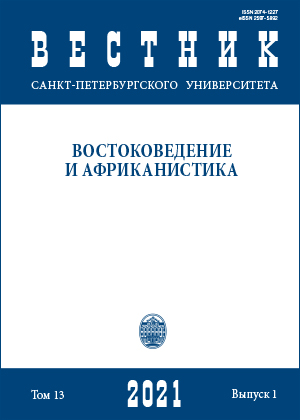Об одной проблеме в изучении хуситского движения (три клише антихуситской пропаганды)
DOI:
https://doi.org/10.21638/spbu13.2021.105Аннотация
Определены и проанализированы три основных обвинения, которые йеменское правительство и радикальные сунниты выдвигали в 2000-х годах против хуситов: стремление к восстановлению имамата, получение помощи от Ирана и обращение в двенадцатеричный шиизм (джаафаризм). Установлено, что все они не соответствуют действительности и во многом представляют собой проявление проводившейся йеменскими властями на протяжении длительного времени политики дискриминации в отношении практикующих зейдитов, особенно сейидов — представителей зейдитской религиозной «аристократии». Показано, что реставрация в Йемене имамата не была частью реальной политической повестки движения в силу отрицательного отношения к подобной идее большинства населения страны. Утверждения о связях хуситов с иранцами использовались йеменским политическим истеблишментом в целях получения дополнительного финансирования от США и Саудовской Аравии. Х. аль-Хуси не только не являлся шиитом-двунадесятником, но и критически отзывался об одной из основных идей этого религиозного течения — возвращении из сокрытия двенадцатого имама в качестве мессии-Махди. Выдвинуто предположение, что правдоподобность этих обвинений и их принятие многими йеменцами и некоторыми российскими и западными исследователями были обусловлены доминированием в йеменском информационном пространстве антизейдитского дискурса и их квазилогичной взаимодополняемостью: чтобы установить имамат хуситам нужна поддержка, которую логичнее всего искать в оплоте мирового шиизма — Иране, а переход в джаафаризм гарантирует получение такой помощи.
Ключевые слова:
Йемен, зейдизм, имамат, хуситы, Хусейн аль-Хуси, джарудизм
Скачивания
Библиографические ссылки
Загрузки
Опубликован
Как цитировать
Выпуск
Раздел
Лицензия
Статьи журнала «Вестник Санкт-Петербургского университета. Востоковедение и африканистика» находятся в открытом доступе и распространяются в соответствии с условиями Лицензионного Договора с Санкт-Петербургским государственным университетом, который бесплатно предоставляет авторам неограниченное распространение и самостоятельное архивирование.





